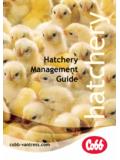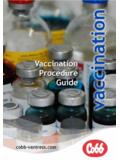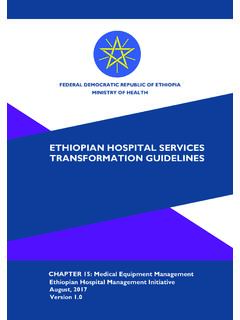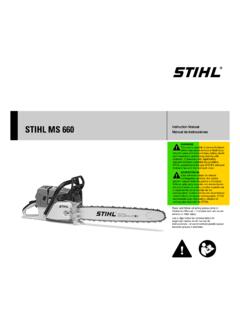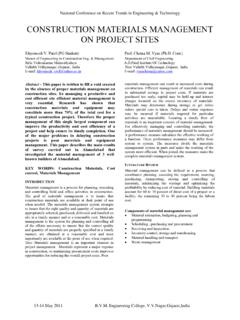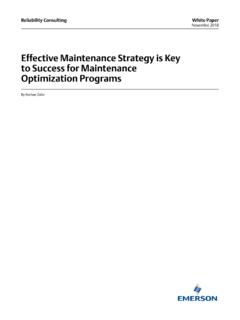Transcription of Cobb Hatchery
1 HatcheryManagement GuideCOBB Hatchery management GUIDE01 Hatchability202 Hatchery Performance Indicators503 Hatching Egg Points of Egg Egg Storage of Egg Storage .. Treating .. and Egg Moisture Transfer2806 Factors Influencing Chick Size3107 Hatcher Hatch and the Hatcher Take-Off and Yield Sexing Broiler Waste Quality and Automation5414 Hatchery Ventilation and Hatcher Exhaust Plenum Through the and Breakout Contaminated Egg Grading Guide77 Embryo Development Chart78 Common Causes of Embryonic Death79 Diagnosis of Hatching Issues80 Chick Hatching Positions81 Chick Grading Guide82 Measurements and Conversions83 Formulas and Calculations84 COBB Hatchery management GUIDECOBB Hatchery management GUIDE1 INTRODUCTIONI ntroductionCobb Hatchery management guide is available online under Resources > management GuidesLook for this Cobb Cares symbol throughout the guide that highlights the Animal Welfare Tips and important aspects of management to improve poultry welfare outcomes throughout
2 The Hatchery and the welfare outcomes of the chicks being delivered to the Welfare TipsA sound understanding of the principles involved in incubating eggs and hatching chicks is vital for maximum hatchability and producing good quality day old chicks. This guide is designed to explain these principles as related to broiler breeding stock and to highlight the main aspects of Hatchery management from egg production to chick guide is provided as a supplement to your Hatchery management skills so that you can apply your knowledge and judgment to obtain the best results. This publication aligns with the Cobb Breeder and Broiler management Guides and supplements (available at: ) to provide technical information beginning with receiving breeding stock supply and continuing to the delivery of broilers for processing. Cobb also offers other technical resources including articles, posters, and videos that can be accessed from our website.
3 Your Cobb Technical Representative is also available to answer questions you may have. Our recommendations are based on current scientific knowledge and practical experience from around the world. You must be aware of local legislations, which may influence the management practices that you choose to Hatchery management GUIDE2 HATCHABILITYThe measure of success of any Hatchery is the number of chicks produced. This number, expressed as a percentage of all eggs incubated, is normally termed is influenced by many factors. Some of these are the responsibility of the breeding farm and others are the responsibility of the Hatchery . Understanding how each factor impacts hatchability can be used to improve production. Although the Hatchery may have no control over certain factors, indicators at the Hatchery can be used as feedback to the farm to improve fertility and hatchability.
4 Thus, it is essential for the farm and Hatchery to work closely together. Collecting and sharing data between farms and hatcheries is a good way to improve results and efficiency. Feedback to the farm should be communicated rapidly and consistently. Both positive as well as negative feedback are useful to consistently produce good results in hatching egg production and first-quality chicks. Hatchability1 Each Cobb product line has specific standards for hatchability. Please refer to the corresponding product supplement for this information (see ).Formula 1 The formula to calculate percentage of hatchability is:Number of Chicks Hatched X 100 = Percentage of hatchabilityNumber of Eggs Incubated COBB Hatchery management GUIDE3 HATCHABILITY Farm Controlling FactorsBreeder Nutrition Nutrition is fundamentally important to the production of eggs, which, in turn, will provide the embryo with all the requirements for development.
5 Deficiencies as well as excess of certain nutrients can be detrimental to hatchability. Nutritional issues in the maternal diet tend to be associated with poor chick quality or mid-term embryonic mortality. Chemical additives including medications and toxins can also negatively impact hatchability. Disease Infection with specific avian diseases can cause abnormalities in egg shapes and/or shell (color and thickness) as well as reduce hatchability. Mating Activity Mating activity typically declines with age of the flock which can reduce the fertility and hatchability of eggs. Mating activity can also be influenced by male behavior, spiking events, and other environmental management factors ( availability of food, space, ventilation, temperature).Egg Handling Eggs with cracks tend to lose moisture more rapidly than intact eggs and the moisture loss can decrease hatchability and chick quality.
6 Cracks in eggs can also be a point of entry for bacteria leading to infection and embryonic mortality. The cuticle is the first line of defense from bacterial contamination and regulates gaseous exchange. Like cracks, damage to the cuticle can increase moisture loss and embryonic mortality. Placing eggs upside down ( pointed ends upwards) and rough handling can also reduce Hatchability may vary depending on the genetic line. Check our guides and supplements for data regarding hatchability of each genetic line (available at: ) Correct Male and Female Bodyweight Over weight breeders are more reluctant to mate and this problem increases with age. Controlling bodyweight controls the rate of decline in female fertility and male sperm quality. Egg Sanitation There is a negative correlation between hatchability and floor eggs as well as washed eggs. Floor eggs are more prone to cracks, fecal contamination and higher bacterial counts on the shell.
7 Floor eggs can also be a source of contamination to other eggs. Washing eggs can reduce the number of bacteria on the shell, but can also damage the cuticle leaving the egg vulnerable to contamination. In general, clean nest eggs have higher hatchability and produce better quality Storage Temperature fluctuations and storage time can both negatively influence hatchability. Temperature data loggers can be used to determine storage times and temperatures, and in turn, can serve as auditing and troubleshooting tools. Breeder flock health status is closely linked to egg quality. Good communication between the Hatchery and production teams is critical to manage health, welfare and quality outcomes for chicks. If the Hatchery reports egg defects, chick quality concerns, and embryo mortality results to production teams, this can help with breeder flock investigation and corrective actions.
8 Animal Welfare TipsCOBB Hatchery management GUIDE4 HATCHABILITY Hatchery Controlling FactorsSanitation A comprehensive sanitation program can lead to high hatchability. Microbial contamination is a leading cause of poor hatchability, reduced chick quality and early chick mortality. Proper containment of contaminated eggs, keeping equipment clean (in-ovo vaccinators, candling equipment, transfer equipment, etc.) and monitoring air quality are crucial factors of any effective sanitation program. Egg Storage Conditions should be dry as wetting eggs can increase the potential for bacteria, dirt and dust to stick to the eggs which may increase the risk of bacteria invading the egg and causing contamination. Temperature fluctuations raising and lowering the egg temperature around physiological zero (24 C; 75 F ) may lead to embryonic death.
9 If air cooling and heating system vents are directed at the eggs during storage, eggs may lose moisture and are more susceptible to aerosolized contamination and temperature fluctuations. (see key points of egg storage section ) Egg Damage Cracked and damaged eggs have a reduced hatchability over intact eggs as cracks and damage to the cuticle make the embryo more susceptible to bacterial contamination and desiccation. Care should be taken anytime eggs are moved, transported or transferred. If eggs are cracked or damaged, the number of eggs should be recorded in daily records. This type of data can help identify issues with hatchability that may relate to employee procedures, equipment maintenance and training. management of Incubators and Hatchers Accurate environmental settings of the incubators and hatchers are crucial to achieving optimal hatchability.
10 Temperatures that are too hot can cause early hatches, dehydrated chicks, reduced absorption of the yolk sac, and unhealed navels. Temperatures that are too cold can also reduce chick quality and cause delays in the hatch window. Likewise, humidity has a large impact on chick quality. Proper moisture loss increases the size of the air cell which allows the chick to pip in the proper position and consequently reduces red or injured hocks. Each manufacturer has variations in functions of their equipment. Be aware of the manufacturer's specifications for the equipment you are using in your Hatchery . Maintenance and Equipment management Equipment failures can be devastating to a Hatchery and result in massive losses. A maintenance plan should include regular, scheduled and preventative maintenance to prevent equipment failures. Replacement and spare parts should be available to prevent delays in repairs.

